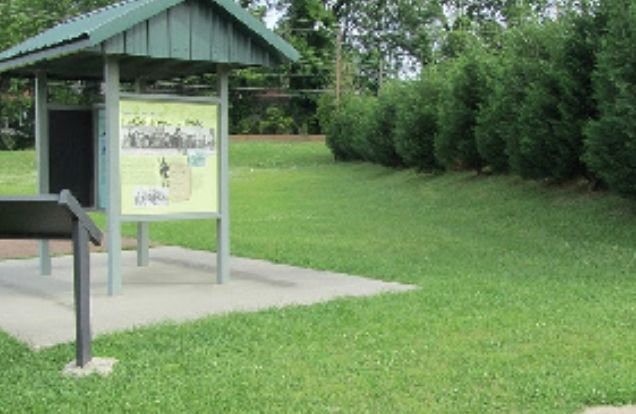News Africa
The chilling story behind Forks of the Road, the slave market turned National Park Service Site

In the city of Natchez is the land, Forks of the Road, which was among the largest slave markets in America between 1833 to 1863. Now, it is a landmark to remember those who suffered bondage there, died, or survived. Last year, officials and residents celebrated the site’s recognition as a new national historical park site.
“History is not always pleasant, but it’s important that history be told, all of it,” Natchez mayor Dan Gibson said in July last year. “It’s a sad story. And I think for many years, there are some who would have been satisfied to see that story forgotten. But how can you forget it?”
Before the Civil War, Natchez was where one could find the second busiest slave-trading market in the Deep South at the site known as the Forks of the Road. Natchez was in the mid-19th century the epicenter of American capitalism, with the trading of some of the world’s most important commodities – land, cotton, and slaves. The National Park Service writes: “With the invention of the cotton gin and an ever expanding steamboat transportation network, Natchez was the ideal location to create an economy centered around slave labor-generated cotton.”
Before the slave market at Forks of the Road was established, slave trading was seen on almost every street corner in the town. A cholera epidemic in the 1830s moved the slave trade business to Forks of the Road, at the intersection of what is now known as Liberty Road and D’Evereux Drive. During this period, tens of thousands of enslaved men, women and children were transported from Virginia, Maryland, Kentucky, and the Carolinas to the market at Natchez against their will and purchased to work as slaves in homes and on plantations.
“This place that I’m standing on, it’s such an important aspect to our history here in Natchez,” Visit Natchez Executive Director Devin Heath said of Forks of the Road to WLBT. “This is where thousands of slaves ended their journey as they were transported in shackles on foot across this country from as far away as Alexandria, Virginia, and other points and marched here to Natchez to be sold at the Forks of the Road. They had to cross over the Spanish Bayou and this bridge at the Forks of the Road to finally come to the end of this journey and the beginning of the next journey in slavery in Natchez.”
From 1833, the slave market operated for some 30 years until the arrival of the Union Army in July of 1863. They were given orders to tear down the slave pens at the Forks of the Road. The U.S. Colored Troops, many of them former slaves, joined them to destroy the slave pens.
“Fortunately, when the U.S. Colored Troops came on board when the unions took over, the slaves were freed,” Natchez Cultural Heritage Tourism Manager Rosco Barnes said. “The troops tore those buildings down and used the lumber (that was used for the slave market) to build Barracks for Fort McPherson, so there is a lot of history involved,” he added.
A member of the 12th Wisconsin Infantry among those who were ordered to tear down the slave pens wrote that the order was met with joy. “This order was received just at evening and was hailed with the wildest enthusiasm by these men who had been chained, gagged and whipped, and suffered tortures unutterable within these same walls, and through that long night they worked with a terrible earnestness and the morning saw the slave pens of Natchez leveled to the ground, never, it is hoped to be again reconstructed,” he wrote.
Last year, the City of Natchez and Mayor Gibson signed over the land (Forks of the Road) to the National Park Service. The historic site which displays among other things an artistic depiction of slave manacles and chains in a concrete form is now an important piece of the National Park System, telling an important story.
-

 Lifestyle3 weeks ago
Lifestyle3 weeks agoRoad Safety Authority narrates how buttocks causes road accident
-

 GENERAL NEWS4 weeks ago
GENERAL NEWS4 weeks agoWhy 15 police officers stormed Owusu Bempah’s church – Kumchacha narrates
-

 GENERAL NEWS3 weeks ago
GENERAL NEWS3 weeks agoWatch how Ibrahim Mahama rode Honda superbike to pay last respects to late friend
-

 GENERAL NEWS4 weeks ago
GENERAL NEWS4 weeks agoHow Offinso residents storm destooled queen mother’s house, demand for new chief
-

 South Africa News4 weeks ago
South Africa News4 weeks agoWoman thrown out of a speeding taxi while on her way to work
-

 GENERAL NEWS5 days ago
GENERAL NEWS5 days agoDeadly clash between youth and navy personnel results in two deaths at Tema Manhean
-

 SHOWBIZ KONKONSAH6 days ago
SHOWBIZ KONKONSAH6 days agoJunior Pope’s Death: Video of John Dumelo refusing to join canoe for movie shoot over safety concerns resurfaces
-

 News Africa1 month ago
News Africa1 month ago‘Satanically dubious’ – SCOAN releases statement on BBC’s report about TB Joshua, church





